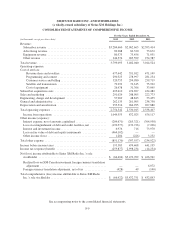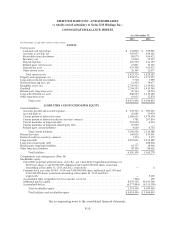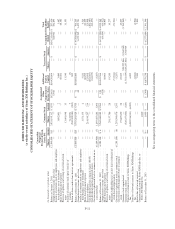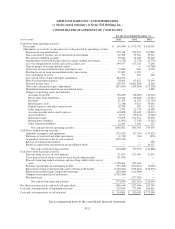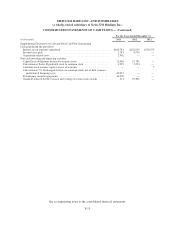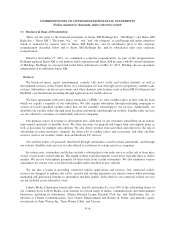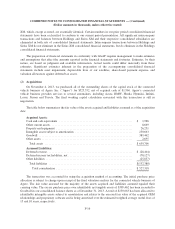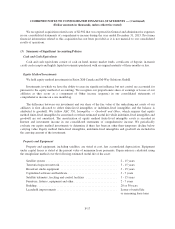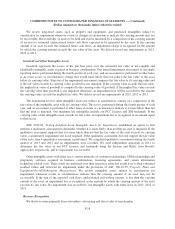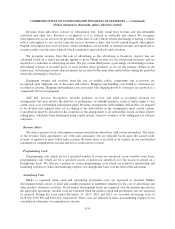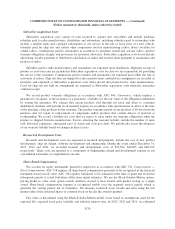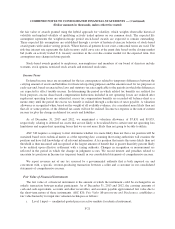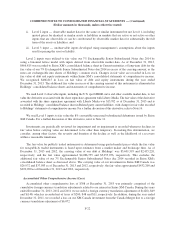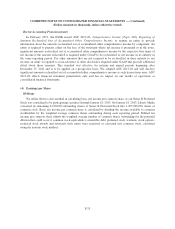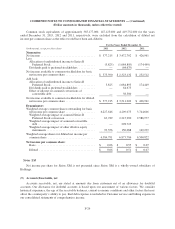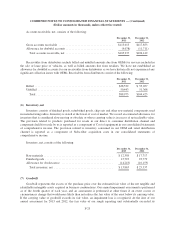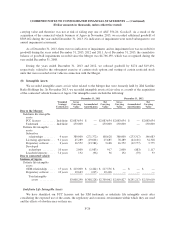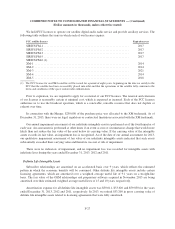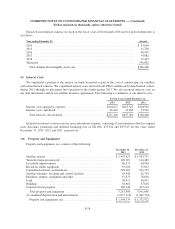XM Radio 2013 Annual Report Download - page 100
Download and view the complete annual report
Please find page 100 of the 2013 XM Radio annual report below. You can navigate through the pages in the report by either clicking on the pages listed below, or by using the keyword search tool below to find specific information within the annual report.COMBINED NOTES TO CONSOLIDATED FINANCIAL STATEMENTS — (Continued)
(Dollar amounts in thousands, unless otherwise stated)
We review long-lived assets, such as property and equipment, and purchased intangibles subject to
amortization for impairment whenever events or changes in circumstances indicate the carrying amount may not
be recoverable. Recoverability of assets to be held and used is measured by a comparison of the carrying amount
of an asset to estimated undiscounted future cash flows expected to be generated by the asset. If the carrying
amount of an asset exceeds the estimated future cash flows, an impairment charge is recognized for the amount
by which the carrying amount exceeds the fair value of the asset. We did not record any impairments in 2013,
2012 or 2011.
Goodwill and Other Intangible Assets
Goodwill represents the excess of the purchase price over the estimated fair value of net tangible and
identifiable intangible assets acquired in business combinations. Our annual impairment assessment of our single
reporting unit is performed during the fourth quarter of each year, and an assessment is performed at other times
if an event occurs or circumstances change that would more likely than not reduce the fair value of the asset
below its carrying value. Step one of the impairment assessment compares the fair value to its carrying value and
if the fair value exceeds its carrying value, goodwill is not impaired. If the carrying value exceeds the fair value,
the implied fair value of goodwill is compared to the carrying value of goodwill. If the implied fair value exceeds
the carrying value then goodwill is not impaired; otherwise, an impairment loss will be recorded by the amount
the carrying value exceeds the implied fair value. We did not record any impairments in 2013, 2012 or 2011.
The impairment test for other intangible assets not subject to amortization consists of a comparison of the
fair value of the intangible asset with its carrying value. This test is performed during the fourth quarter of each
year, and an assessment is performed at other times if events or circumstances indicate it is more likely than not
that the asset is impaired. Our indefinite life intangibles include our FCC licenses and XM trademark. If the
carrying value of the intangible asset exceeds its fair value, an impairment loss is recognized in an amount equal
to that excess.
ASU 2012-02, Testing Indefinite-Lived Intangible Assets for Impairment, established an option to first
perform a qualitative assessment to determine whether it is more likely than not that an asset is impaired. If the
qualitative assessment supports that it is more likely than not that the fair value of the asset exceeds its carrying
value, a quantitative impairment test is not required. If the qualitative assessment does not support the fair value
of the asset, then a quantitative assessment is performed. We completed qualitative assessments during the fourth
quarter of 2013 and 2012 and no impairments were recorded. We used independent appraisals in 2011 to
determine the fair value of our FCC licenses and trademark using the Income and Relief from Royalty
approaches, respectively, and no impairment was recorded.
Other intangible assets with finite lives consists primarily of customer relationships, OEM relationships and
proprietary software acquired in business combinations, licensing agreements, and certain information
technology related costs. These assets are amortized over their respective estimated useful lives to their estimated
residual values and reviewed for impairment under the provisions of ASC 360-10-35, Property, Plant and
Equipment/Overall/Subsequent Measurement. We review intangible assets subject to amortization for
impairment whenever events or circumstances indicate that the carrying amount of an asset may not be
recoverable. If the sum of the expected cash flows, undiscounted and without interest, is less than the carrying
amount of the asset, an impairment loss is recognized as the amount by which the carrying amount of the asset
exceeds its fair value. No impairment was recorded to our intangible assets with finite lives in 2013, 2012 or
2011.
Revenue Recognition
We derive revenue primarily from subscribers, advertising and direct sales of merchandise.
F-18



